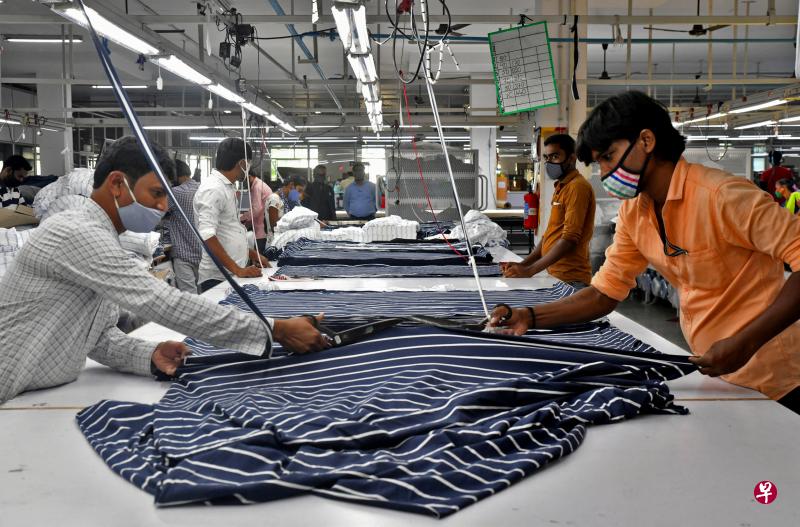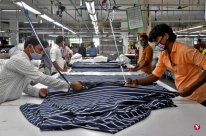
Apple plans to produce new smartphones in India. For the first time this year, some laptop MACBOOK will be produced in Vietnam.
China's blockade policy during the crown disease, and the geopolitical risks of dominating dominance in the fields of Sino -US in the fields of semiconductors, Class = zbo_intro> seems to turn into east winds, allowing investors who pursue the diversification of the supply chain to turn their eyes again to India and Vietnam.
One is the second largest country in the world, and the other is "mini China", which was once known as Southeast Asia; can these two countries really rise to become the next world factory?
Make in India -This is the ambitious plan proposed shortly after India's Prime Minister Modi in 2014.
At the end of October last year, Modi shouted this slogan again while holding a foundation ceremony for an aircraft manufacturer in Gujarat, but this time he added an extra sentence in the back: Made for the worldDi wants to promote India to become a greater ambition to become a global manufacturing hub.
SP Global and Morgan Stanley's recent reports show that by 2030, India will surpass Japan and Germany to become the third largest economy in the world.Chetan Ahya, chief Asia Economist at Morgan Stanley, predicts that in the next 10 years, the Indian economy will account for one -fifth of global growth.
Indian Enterprise Management Consulting Company Stratefix co -founder Gial said: "I do believe that foreign companies are increasingly inclined to transfer to India to establish a manufacturing base.The place of manufacturing is not good for them. "
Michael Spence, a winner of the Nobel Prize in Economics, is even more blunt that India "is still the most popular investment destination."
Where is the strength of India, will analysts and economists optimistic about its future development of the manufacturing industry?
Amitendu Palit, a senior researcher at the National University of Singapore's South Asia Research Center, mentioned several main advantages of India when he was interviewed by Lianhe Zaobao."India is located in the strategic economic position between East and West Asia. Whether it is sea or land, it has a good connection with Central Asia, West Asia, Southeast Asia, and East Asia, which makes it a favorable location for all regions of Asia.
"Secondly, for many industries, India has a young and liquid labor team. They can easily flow throughout the country, have high skills, and learn fast. In addition, India has strong and mature capitalThe market, with a large number of advanced financial products, can quickly mobilize funds including overseas markets. "
Arvind Subramanian, who had served as an Indian government economic adviser from 2014 to 2018, and Josh Felman, a senior resident representative of the International Monetary Fund in India.Joint writing pointed out that India does have some structural advantages.
Indian adults' young people can improve English infrastructure to actively attract foreign investment
India's area is nine times that of Germany, one of the few countries that are enough to accommodate many large industries.
Its 1.4 billion population will soon surpass China, becoming the country with the largest population in the world, and reaching a peak of 1.7 billion after 2060.More importantly, India's population is relatively young, talented, and speak English, which is an important backbone of the national labor force.
In recent years, India's physical infrastructure has improved significantly. Digital infrastructure, especially financial payment systems, has even surpassed the United States in some ways.
The Indian government also actively takes measures to attract foreign investment, including the launch of the "Production-Linked Incentives" in early 2021. It provides economic reward measures for domestic and foreign manufacturers in advanced fields such as telecommunications, electronics, and medical equipment.
In September last year, Apple, the United States, announced that it plans to produce 5 % to 10 % of new smartphone iPhone 14 in India.Foxconn will also cooperate with Indian mining group Vedanta Resources to build a semiconductor factory in India in India.
Parite said: "Smartphones are mostly a supply chain in India. Apple's contract manufacturers such as Foxconn, Heduke and Weichuang have launched business in India. Their suppliers are also planned to be in IndiaEstablish a base. In the future, Apple should be produced in India at least one -third of the iPhone, which will make India an important place and source of the export of iPhone and export to the third country market. "
Dr. Jayant Menon, a senior researcher at the Easov Isaev Isa East South Asian Research Institute in Singapore, told Lianhe Zaobao: "India's current advantage is its high -skilled activities in manufacturing, including testing and design.Compared with the labor -intensive field, administrative barriers are not so important. "
Although India's statement is full of investment destinations, there are actually not many evidence that foreign companies intend to transfer production lines to India.In the past 10 years, India's overall foreign direct investment has stagnated and has maintained about 2 % of GDP (GDP).
For companies that have seized the opportunity to develop in India, many unsuccessful experiences, including Google, US retail giant Walmart, General Motors, etc.
Even e -commerce giant Amazon is struggling, and in late November last year, it was announced that it was closed in three joint ventures in India, including food distribution, education and wholesale e -commerce.
Ashutosh Sharma, director of business consulting company Forreser, told the American business inside story: "India is far from companies that companies can simply come in to open stores, and then there is no need to comply with too many corporate compliance requirements. I must be in China in ChinaThere are also these problems, but it quickly solves these compliance requirements is much higher than India ... India has too many interest -related stakeholders to be satisfied. "
A amp) all the blocks of the puzzle. "High investment risk high policy introverted or blocked India becomes a world factory
Shama takes China as an example that China has successfully established oneThe extensive value chain can almost find all raw materials required for and purchase manufacturing products in China, which allows China to produce large -scale production at low cost."In contrast, India does not have this ability yet, which takes a few years to establish it."
In a joint article published by foreign affairs, Saerblamannia and Felmann listed the three major obstacles to India to become the next world factory: the investment risk is too high, the policy introverted is too strong, and the macro macro is macroEconomic imbalance is too great.
They pointed out that companies still lack confidence in the Indian government, and they are worried that they will change after their investment policies when they invest, so that they will eventually be inaccurate.Enterprises cannot determine whether India officially enforces relevant trade rules fairly, and will not tend to government large domestic enterprises.
One of the key elements of India's "Manufacturing Reward Program" is to increase tariffs on foreign manufacturing components. The original intention was to encourage enterprises to move to India and buy materials in the Indian domestic market.However, advanced products in many fields are generally composed of hundreds or even thousands of parts, and these parts come from the world's most competitive manufacturers.India's high tariffs on these parts have undoubtedly allowed companies that intend to invest in local investment.
Even if it cooperates with large domestic companies in India, it is difficult for foreign companies to reduce investment risks, because the Indian government confirms that it is not a partner who is not completely asking for business.
At the end of last year, the Indian commercial giant Tata Group and Airbus cooperated projects for the Indian Air Force manufacturing military aircraft, because it was originally scheduled to set up a factory in Maharashtra, Maharashtra,The plan finally fell to Gujarat, causing a political dispute.A former minister claimed that these companies revealed where they could not choose where to set up a factory because the location was determined by the Modi government.
Mei Nong also said to this newspaper that India needs to solve various domestic problems related to high business costs in order to increase its participation in the global supply chain.He said: "India has been actively seeking a free trade agreement with trading partners, but what it lacks is the internal free trade agreement, which can create a common domestic market and production base for India. Transportation products and services between the stateIf it is difficult, it will continue to limit India's potential to attract foreign direct investment. "
Vietnam's near China has an advantage but limited human area
 "
"
Since 2019, Vietnam has been transformed into a manufacturing center and has attracted many new investment from different countries.The semiconductor industry that has been booming in Vietnam in the past few years has now accounted for one -third of Vietnam's total exports.
Vietnam Statistics General Administration of Statistics shows that in the first 11 months of 2022, the export volume of mobile phones and components was the highest, reaching 55.4 billion US dollars (about 74.6 billion yuan), an increase of 6.6 % over the same period last year.
Li Honghe, a senior researcher at the Erv Isa Eastern South Asian Research Institute, said in an interview with Lianhe Morning Post: "As the multinational enterprises seeking diversified multinational enterprises continue to transfer manufacturing facilities from China to other countries, Vietnam is benefiting from it. Therefore, it is therefore benefited.There is potential to become the main manufacturing center of the world. "
He pointed out that even if multinational companies set up factories outside China, China is still the main source of supply of these enterprises. From a geographical point of view, Vietnam near China has a greater advantage over India.He said: "These transnational companies imported raw materials or components from China to Vietnam's logistics costs will be lower than the costs they must pay for factories in India or other countries in India or Southeast Asia."
In addition, Vietnam is a member of more than 15 free trade agreements.For multinational companies that want to expand exports to other parts of the world, Vietnam is an attractive destination.
Li Honghe said: "Vietnam's infrastructure is improving, and labor costs are relatively low. Vietnamese workers are also considered to have higher skills and discipline than employees in other countries.Investment, especially investors, especially high -tech manufacturing, are all the advantages that Vietnam can strengthen. "
Ho Quoc Tuan, a senior lecturer at the University of Bristol University in the United Kingdom, replied that Vietnam also agreed with Vietnam's advantages in labor costs, geographical location, political stability, and signing a number of free trade agreements during an email interview.
does not have the Chinese market and labor scale
But he believes that Vietnam is still difficult to shake China's world factory status in the short term.He said: "At this stage or in the near future, Vietnam cannot compete with China or Taiwan in production cutting -edge products. It may be a simpler step in Vietnam's participation in the process of production chips.With the needs of Vietnam, it will be difficult to get up quickly. "
Li Honghe also believes that Vietnam does not have China's market and labor scale.
Vietnam's population in 2022 is about 98.17 million. Although the labor force is sufficient, the area is greatly limited from India.Vietnam's land area is about 330,000 square kilometers, but the plain area is less than 20 %, the mountains account for 40 %, and the tropical forest covers an area of 42 %.
This is just a limitation of the geographical situation. Li Honghe believes that the more important issue is that there are not many Vietnamese suppliers that can supply factories for multinational companies. These multinational companies still have to be imported from other countries, especially in China,Materials and parts.
Analysis: To become a mature world factory Vietnam must improve infrastructure training talents
Li Honghe revealed that the Vietnamese government is trying to change this situation and encourage Vietnamese companies to improve its research and development and manufacturing capabilities to become part of the global supply chain of multinational companies.
Vietnam's efforts obviously have some achievements.At the end of last month, Samsung's research and development centers built at a $ 220 million in Hanoi were officially launched.More than half of Samsung's smart phones are produced in Vietnam. Today, it has opened the largest R & D center in Southeast Asia in Hanoi, showing that Samsung intends to build Vietnam as an important global strategic base for the company.
Samsung is the largest foreign investor in Vietnam, with a total registered investment of nearly $ 20 billion.Vietnamese Prime Minister Fan Mingzheng urged Samsung to accelerate the plan to produce semiconductor parts in the local area last month. It is hoped that by July 2023, Samsung's factories in Taiyuan can start large -scale production chips.
Li Honghe said: "To attract more world -class investors in the manufacturing field, Vietnam also needs to further improve the infrastructure and improve some labor skills, re -training for them, and further crack down on corruption."
Hu Guojun pointed out: "Vietnam will become a truly mature world factory. The government needs to invest and encourage investment in the private sector to cultivate young talents and re -train existing labor.This is very important, because the current expenditure for infrastructure construction in Vietnam is slow, and the efficiency of state -owned enterprises needs to be improved. "
Senior researcher at the South Asia Research Center Parite believes that Vietnam may be an excellent place of investment, but as far as the domestic market size is concerned, Vietnam is still unable to compare with India.he: "The huge domestic market in India means that its manufacturing industry can be facing the domestic market, or export -oriented; Vietnam can only be based on overseas markets."
For what other countries have the potential to become the next world factory, Parit is optimistic about the UAE, Nigeria and Turkey.
Li Honghe said: "I think Indonesia may become a powerful competitor. Indonesia has a huge domestic market, huge labor force, rich natural resources, and the government's relatively competitive strategies. Geographically,It is not too far away from China. "



